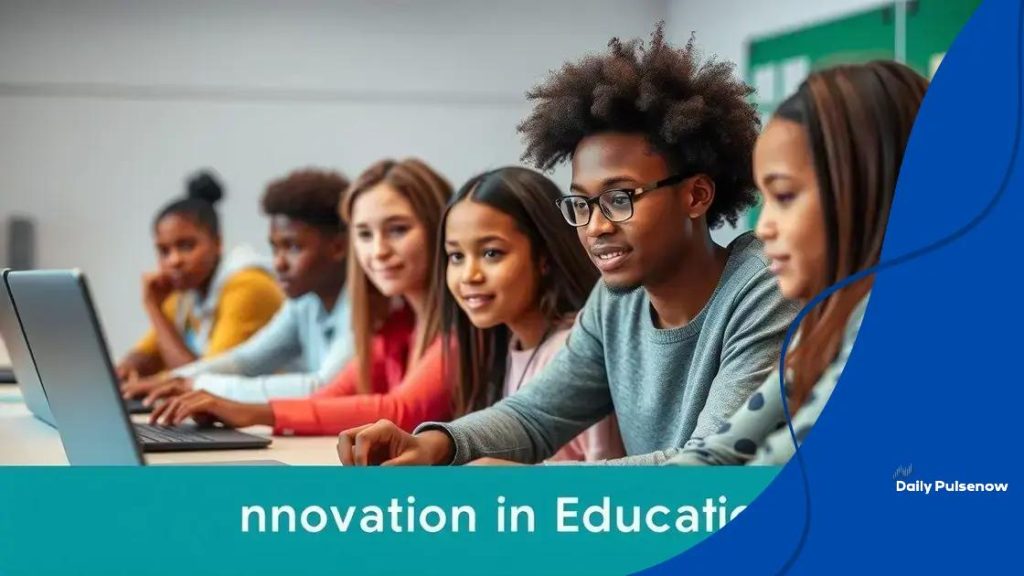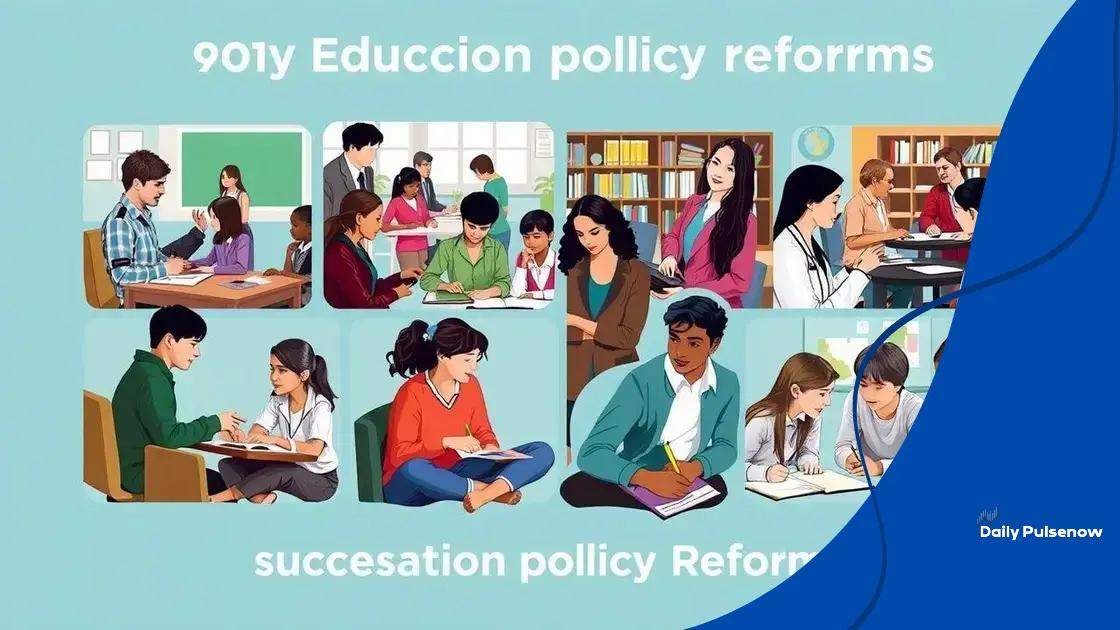Education policy reforms: transforming the future of learning

Anúncios
Education policy reforms aim to enhance student engagement and learning outcomes by focusing on personalized learning, technology integration, social-emotional learning, and collaboration among stakeholders.
Education policy reforms play a crucial role in shaping the future of learning and student success. Have you ever considered how changes in policy could directly impact your educational experience? In this article, we’ll explore the nuances of these reforms and their significance.
Anúncios
Understanding the importance of education policy reforms
Understanding the importance of education policy reforms is essential for anyone interested in the future of learning. These reforms can create significant changes that benefit students and educators alike. They aim to improve classroom experiences and better prepare individuals for real-world challenges.
Why Policy Reforms Matter
Education policy reforms are critical because they address the changing needs of society. As technology advances, the demands in the workforce evolve, making it necessary for educational systems to adapt. Without reforms, schools risk falling behind.
Key Benefits of Education Reforms
- Enhancing student engagement and motivation.
- Improving teaching strategies for better learning outcomes.
- Promoting equal opportunities for all students.
- Focusing on 21st-century skills, such as critical thinking and collaboration.
The ongoing evaluation of current policies ensures that education responds effectively to societal needs. This process involves educators, policymakers, and community members working together. When these groups collaborate, they can identify areas that require change and develop innovative solutions.
Anúncios
Moreover, effective reforms are often data-driven. By analyzing student performance and outcomes, education leaders can make informed decisions. For instance, if there’s a significant gap in learning across demographic groups, policies can be adjusted to target resources where they’re needed most.
In today’s fast-paced world, a responsive education system is vital. Education policy reforms not only equip students with necessary skills but also create a supportive environment that fosters lifelong learning. This adaptability is crucial for ensuring that every student has the chance to succeed, no matter their background.
Key areas of focus in education reforms
Focusing on key areas is vital for effective education reforms. These areas not only drive improvements but also ensure that policies align with the needs of students and educators. Understanding these focus points helps stakeholders make informed decisions.
Curriculum Development
Curriculum development is one of the primary areas in education policy reforms. A modern curriculum should emphasize critical thinking, creativity, and real-world applications. Schools need to integrate technology and current events into lessons to keep content relevant and engaging.
Teacher Training and Support
- Providing ongoing professional development.
- Encouraging collaboration among educators.
- Implementing mentorship programs for new teachers.
Another crucial aspect is teacher training and support. Teachers are the backbone of any education system. By investing in their development, policymakers can ensure they are equipped to handle diverse student needs. Supportive environments can lead to better teaching outcomes, which benefit students directly.
Equity and Inclusion
Education reforms must address equity and inclusion. All students deserve access to quality education, regardless of their background. Policies should aim to eliminate disparities that affect underprivileged communities. This can be achieved through targeted funding and resources, ensuring that every child has opportunities to succeed.
Assessment and accountability are also essential components of education policy reforms. By creating systems that monitor student progress, schools can identify strengths and weaknesses. This data-driven approach allows educators to tailor their teaching strategies based on specific needs.
In the realm of education reform, technology integration plays a vital role. Schools must embrace technology to enhance teaching and learning experiences. Innovations like online learning platforms and educational software can provide interactive and personalized learning opportunities.
Case studies: successful education policy reforms

Examining case studies of successful education policy reforms reveals valuable lessons that can be applied widely. These real-world examples showcase the impact of effective reforms on student learning and school environments. By understanding what worked in these cases, we can glean insights for future initiatives.
1. Finland’s Education System
Finland is renowned for its education reforms. The country focuses on less standardized testing and more emphasis on student well-being. Teachers are highly qualified and trusted to design their curricula. This approach fosters an atmosphere of creativity and learning, leading to high student performance.
2. The No Child Left Behind Act (NCLB)
In the United States, NCLB aimed to close achievement gaps. While not without challenges, it highlighted the importance of accountability in education. Schools began to track student progress, ensuring that all groups were receiving quality education. This increase in transparency has put pressure on schools to improve continuously.
3. The Harlem Children’s Zone
The Harlem Children’s Zone (HCZ) offers another compelling example. This initiative provides a continuum of support from birth through college, focusing on the entire community. By integrating social services with education, HCZ has improved student outcomes significantly, showcasing the benefits of a holistic approach.
Successful education policy reforms often involve community engagement. Involving parents and local groups fosters pride and responsibility in education. When communities feel invested, the likelihood of successful outcomes increases.
Policies that prioritize teacher support and collaboration also yield positive results. For example, mentoring programs for new teachers can enhance retention and performance. When teachers are empowered and supported, students benefit from higher-quality instruction.
Challenges faced in implementing education reforms
Implementing education reforms often comes with various challenges that can hinder progress. Understanding these challenges is crucial for developing effective strategies. This awareness can help stakeholders prepare for obstacles and work towards overcoming them.
Resistance to Change
One significant challenge is resistance to change. Many educators and administrators may feel hesitant about new policies. This resistance can stem from fear of the unknown or concerns about additional workload. Building a strong support system and providing adequate training can help alleviate these fears.
Funding Issues
- Lack of financial resources can stall reforms.
- Balancing budget priorities can be difficult.
- Ensuring funding is allocated effectively is crucial.
Funding is another critical factor in the success of education policy reforms. Many schools struggle with limited budgets, making it challenging to implement necessary changes. Resources may become stretched thin, resulting in incomplete or ineffective reforms.
Accountability and Assessment
Accountability measures can also present challenges. Standardized testing often dominates the educational landscape, leaving little room for innovative teaching methods. These rigid assessment structures can make it difficult for educators to adapt curricula to meet diverse student needs.
Another obstacle to reform is ensuring all stakeholders are involved in the process. Education reforms require collaboration among teachers, parents, administrators, and policymakers. When there’s a disconnect between these groups, it can lead to miscommunications and ineffective implementation strategies.
Moreover, societal and cultural factors can impact the acceptance of reforms. Communities might have different values regarding education, and aligning these values with incoming policies can be daunting. Understanding and respecting local contexts is fundamental for effective reform.
Future trends in education policy reforms
Looking ahead, future trends in education policy reforms will likely shape the way learning occurs in classrooms worldwide. Understanding these trends is essential for educators, policymakers, and stakeholders to stay informed and adaptable to changes.
Personalized Learning
One major trend is the push towards personalized learning. This approach focuses on tailoring education to meet individual student needs and learning styles. Technology plays a key role, enabling teachers to monitor progress and adjust lessons accordingly to enhance student engagement.
Integrating Technology
- Utilizing artificial intelligence for adaptive learning.
- Incorporating virtual and augmented reality in lessons.
- Enhancing digital literacy across all grades.
Integrating technology into education is another growing trend. Schools are increasingly adopting tools like AI to create personalized learning experiences. Virtual and augmented reality can bring subjects to life, helping students grasp complex concepts. Furthermore, ensuring students develop strong digital literacy skills is crucial in our technology-driven world.
Social-Emotional Learning (SEL)
Social-emotional learning is gaining traction as part of education reforms. Schools are now recognizing the importance of developing students’ emotional intelligence alongside academic skills. By implementing programs focused on empathy, teamwork, and self-regulation, educators can foster a supportive learning environment that promotes overall well-being.
Equity in education remains a pressing concern. Future reforms will likely prioritize ensuring all students have access to quality education, regardless of their background. Policymakers are focusing on addressing systemic barriers that hinder success for underrepresented groups.
Collaboration between stakeholders will be essential for effective reforms. Engaging parents, communities, and educators in the decision-making process encourages shared responsibility and enhances the impact of educational policies. By working together, we can create more inclusive and effective educational environments.
FAQ – Frequently Asked Questions about Education Policy Reforms
What is personalized learning?
Personalized learning tailors education to meet individual student needs, allowing them to learn at their own pace.
How does technology impact education reforms?
Technology enhances learning experiences by providing tools like AI, virtual reality, and online resources that engage students more effectively.
What is social-emotional learning (SEL)?
SEL focuses on developing students’ emotional intelligence, helping them understand and manage their emotions and build healthy relationships.
Why is collaboration important in education reforms?
Collaboration among educators, parents, and the community fosters shared responsibility and strengthens the overall impact of educational policies.